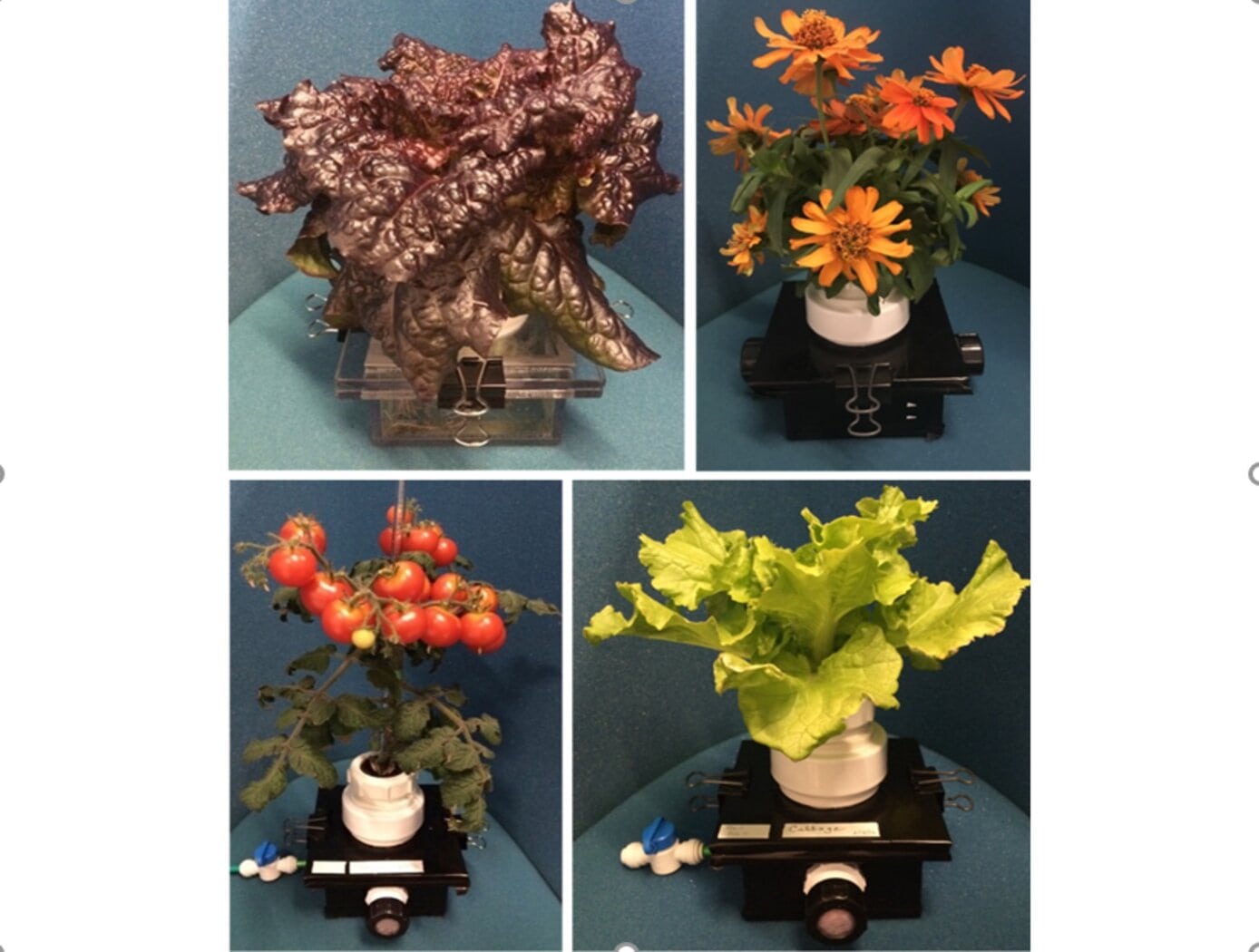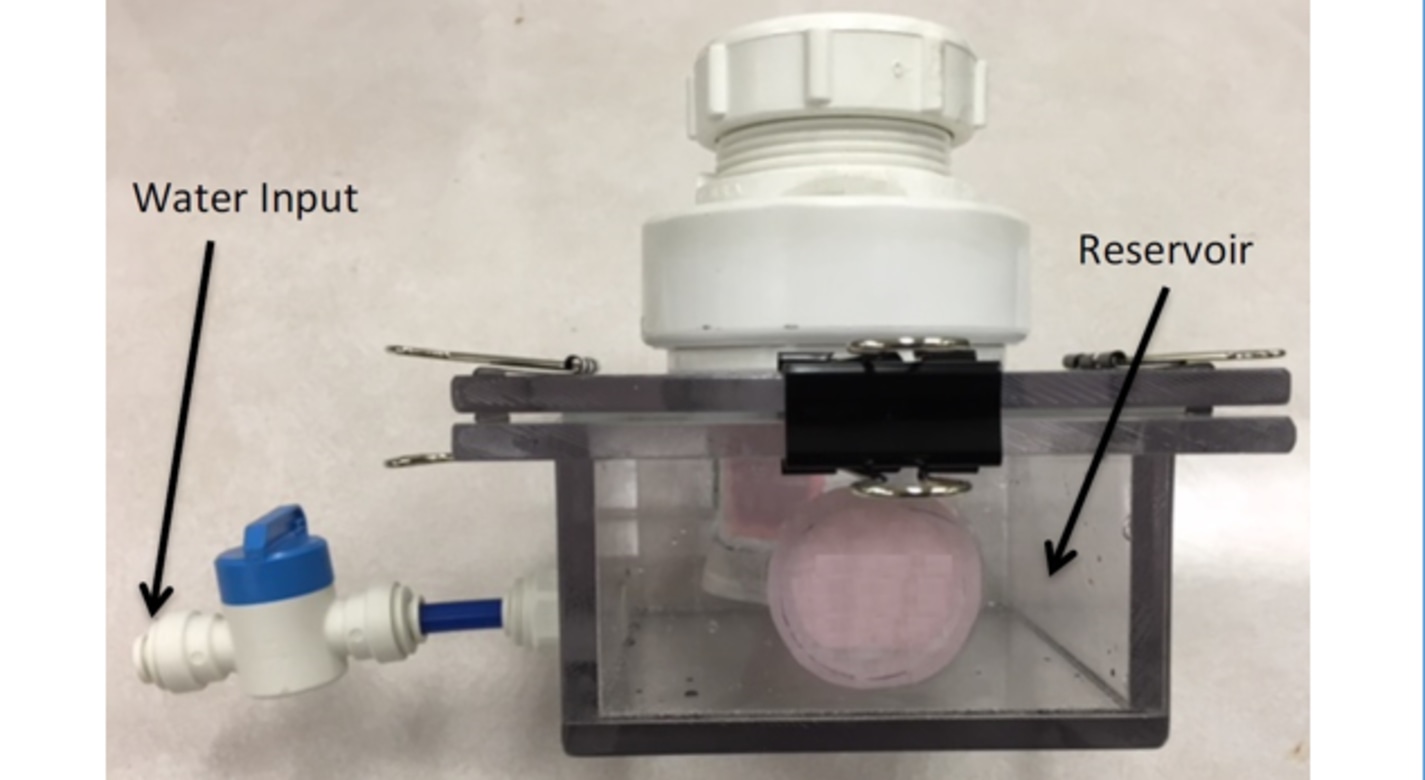Passive Nutrient Delivery System (PONDS)
Environment
Passive Nutrient Delivery System (PONDS) (KSC-TOPS-81)
Water and nutrient delivery for controlled agriculture environments
Overview
Reliable seed germination and plant production requires an environment that is neither too dry nor too wet. PONDS was developed to improve water and nutrient delivery for plants grown on the International Space Station (ISS). The technology uses an innovative wicking material to passively link a water/nutrient reservoir to a growth cylinder where seeds are germinated and plants are produced. PONDS addresses limitations with existing ISS plant-production technology by providing consistent delivery of water/nutrients, improving oxygen transfer to plants, and allowing users to determine how much water is being applied.
The Technology
PONDS was developed as a water/nutrient delivery system for the Vegetable Production System, called VEGGIE, on the International Space Station (ISS). PONDS uses an innovative wicking material to passively link a water/nutrient reservoir to a plant cylinder. The system enables higher germination rates and improved growth conditions compared to the VEGGIE water/nutrient delivery system currently used on the ISS.
PONDs consists of two primary components: a water/nutrient reservoir (Figure 1), and a detachable plant cylinder containing growth substrate and wicking material (Figure 2). The reservoir includes a viewing window that allows the user to observe and record water-use data. The plant cylinder, which screws into the reservoir system, is made from commercial-off-the-shelf materials and fittings. Both the reservoir and plant cylinder include oxygen-permeable windows to enhance aeration to the root zone.
Water is delivered from the reservoir to the substrate contained within the plant cylinder via the wicking material inserted into the growth substrate. The wicking material is intrinsically hydrophilic, providing improved capacity compared to the system previously used with VEGGIE. As a result, PONDS can continuously supply water to the root zone within the plant cylinder on demand.


Benefits
- Effective: prevents issues with over- or under-watering of plants in controlled-growth environments
- User-friendly: allows user to monitor water levels
- Versatile: can be used in 1-g or microgravity environments, and can be sized to accommodate either smaller or larger plants
- Simple design: can be constructed using commercial-off-the-shelf components
Applications
- Controlled Environment Agriculture (CEA): commercial- or consumer-based indoor farming
- Education: tool for science, technology, engineering, and mathematics (STEM) curricula/students
Technology Details
Environment
KSC-TOPS-81
KSC-14031
https://ntrs.nasa.gov/api/citations/20210022119/downloads/Stars%20APH%20PONDS%20Talk%202021.pdf
https://ntrs.nasa.gov/api/citations/20190033278/downloads/20190033278.pdf
Similar Results

Passive Porous Tube Nutrient Delivery System
The Passive Porous Tube Nutrient Delivery System is a plant growth technique that delivers a nutrient solution to the roots of plants via capillary action. The system was designed for use in microgravity. This new system utilizes a ceramic porous tube and water/nutrients bags connected in a loop. No electricity or moving parts are required. Instead, the nutrients are pumped in through a combination of capillary force and evapotranspiration from the plant. The porous tube supplies the plants with the water and nutrients needed to germinate and grow. This system provides an autonomous plant growth apparatus that is simple to assemble, plant and harvest, minimizing the amount of intervention needed in micro-gravity.

Microwave-Based Water Decontamination System
Bacterial contamination of water systems used in microgravity is a major issue for NASA because biofilms can clog or interfere with water system functions and bacterial ingestion can be harmful to astronaut health. To address this problem, NASA innovators developed a microwave based technology to purify contaminated water by eradicating and eliminating bacteria that grows in systems that generate potable water, in equipment utilizing cooling loops and heat exchangers, and removing bacterial contamination that is present on a variety of surfaces. This decontamination system is chemical free and requires minimal to no consumables.
Initial testing identified a specific microwave frequency band and exposure times for killing bacteria (Burkholderia cepacia) and biofilm. Test results show that exposing static water to microwave energy for 90 seconds can effectively kill waterborne bacteria and biofilm within a water filtration system. Additional testing, using a circulating water test bed, demonstrated that microwave energy at the selected frequency can effectively eradicate waterborne bacteria within 30 seconds. This technology could be further developed into a portable, lightweight system for use in remote locations as well as commercial space applications. The microwave decontamination system could also be added to existing water systems to extend the life of the system.

Pre-Treatment Solution for Water Recovery
The pre-treatment solution increases the solubility of calcium in urine brines by reducing the concentration of sulfates. When the solution is properly dosed, it enables biological, physical, and chemical stabilization of flushed urine for storage and distillation up to a steady 87% water recovery, as realized aboard the U.S. segment of the ISS, without precipitation of minerals such as gypsum.
Turning wastewater or seawater into potable water requires three important steps shared by the UPA and Water Recovery System (WRS) aboard the ISS: 1) pre-treatment, 2) distillation or membrane filtration, and 3) transport and storage of potable water and brine. Added during the first step, the pre-treatment solution improves the efficiency of the UPA by reducing the formation of solid precipitates caused by urinary calcium, sulfate ions, and sulfuric acid. This reduction in-turn creates less acidic brines which means more water can be recovered along with less surface scaling and clogging, further increasing recovery. As an added benefit, the solution contains a biocide that prevents the growth of bacteria and fungus, thereby increasing storage time of the treated urine.
Although the pre-treatment solution was developed for the ISS’s UPA , the technology can potentially be used on Earth to pretreat contaminated water from organic-laden, high-salinity wastewaters. Adding the solution is a simple process that can be scaled to fit demand. It has the potential to improve water recovery in many applications such as: desalination plants, brackish water treatment, mining water treatment, hydraulic fracturing operations, and more. The pre-treatment solution may also lend itself for use in the transport and storage of wastewater due to the solution's ability to prevent microbial growth.

Modular System for Waste Treatment, Water Recycling, and Resource Recovery
Because resupply of commodities for long duration space missions would be prohibitively expensive and could take an extensive length of time to reach habitats in orbit around or on other planetary bodies, it is critical that astronauts have the ability to recycle and reuse local waste streams to provide resources such as clean water, fuel, and nutrients for growing plants. Scientists at Kennedy Space Center and the University of South Florida have developed a technology that addresses this critical mission need. The modular system design incorporates all wastewater streams and some food waste including urine water, hygiene water, humidity condensate, Sabatier water, fecal waste, laundry water, and organic food waste. These sources are fed simultaneously into the system, and a function-driven, sequential purification process occurs. The primary processes include carbon conversion, phase separation (solid/liquid/gas), disinfection, nutrient/salts management, and salts balancing to generate a clean water stream. The heart of the closed-loop bio-regenerative system is an anaerobic membrane bioreactor (AnMBR), which takes raw wastewater streams and utilizes an anaerobic microbial consortium to carry out the breakdown of the organic matter. An ultrafiltration membrane captures and destroys pathogenic bacteria and viruses. The AnMBR system generates a clean water stream containing fertilizer constituents which can be used to cultivate either microalgae (for food, pharma/nutraceuticals, fuel or bioplastics) in photobioreactors or crops in hydroponic systems. The system also generates methane and hydrogen gas which can be used for fuel (or conversion to bioplastics), and CO2 which can be used to support plant growth.

Surface Attached BioReactor (SABR) for Microbial Cell Cultivation
The Surface-Adhering BioReactor (SABR) is a novel microbial cell cultivation platform that mimics the way vascular plants use transpiration to deliver nutrients to their cells. In this biomimetic platform, microbial cells are cultivated as immobilized cells on a porous substrate where transpiration is used to passively deliver water and nutrients as well as harvest and concentrate secreted biomolecules by the microbial cells. The SABR transports nutrients to microorganisms without using a pump. Instead, evaporation and the cohesive property of water are exploited to pull the nutrient medium through the device, with a high degree of control, on an as needed basis. It eliminates the hydrodynamic shear stress on the cells and decreases the working volume of water needed for cultivation by a factor of 25 compared to planktonic bioreactors. Furthermore, the transpiration mechanism allows for the concentration of secreted products in areas of relatively fast evaporation, thus providing a passive means of secreted product harvesting. By matching the time scales of nutrient medium delivery and product harvesting with the time scales of growth and product formation, minimal energy is wasted in bioreactor operation. Transpiration enables a passive cooling system for the cells where either externally imposed or internally generated heat due to cellular activity is mitigated, thus preventing overheating that can lead to decreased productivity or even cell death. This technology enables significant reductions in energy input for cultivating microorganisms.



